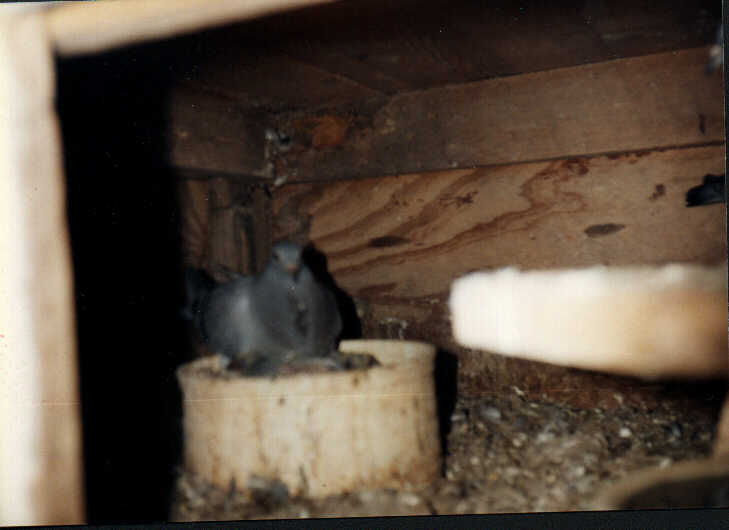Unpublished.
Squeaker broods sibling squabs.
by Robert J. Mangile
After more than 40 years of pigeon keeping, one would think that every aspect of their behavior has been observed. Fortunately, every now and then, something new occurs that really fascinates, even the old, pigeon fanciers.
There is something mysterious and captivating about the mating and nesting rituals of all birds in general; not just the domestic pigeon. But we are among our pigeons daily and some of the subtleties we see and recognize are never mentioned nor can they be described accurately.
During September 1992, I was fascination by an event that will stay in my memory forever. Not since May 9, 1963, when I witnessed a squeaker feeding another squeaker, have I been so intrigued with pigeon behavior ( see, “Squeakers Feeding Squeakers", A.P.J., June 1964, page 35.), But..., before describing what I saw, I'll try to set the stage a bit.
Fanciers who breed from individual breeding coops of modest size are fully aware that when the next clutch of eggs are due to hatch, the squeakers that are of fledgling age sometimes come under attack by the adult birds in that coop. Generally, it is the cock that begins attacking one of his offspring in an effort to drive it from the nest site. This would probably not occur, but under such artificial conditions this type of behavior is expected and anticipated. Therefore, one must be aware of the approximate hatching time of the next clutch of eggs, and make a timely removal of the near fledgling squeakers.
On occasion, the next clutch will hatch unexpectedly, or before the squabs appear capable of caring for themselves. This sets up a tense situation in the breeding coop, and sometimes the cock will attack the fledglings. When the squeakers are of particular value to the breeder, the next clutch of eggs can be fostered out to another pair; which usually breaks-up the attack cycle. Another possibility is to offer the squeakers a place to hide, out of sight of the adults. One very effective method I've used, is to remove the hen from the coop; and the cock promptly quits attacking the fledglings.
On September 12, 1992, while taking notes of my birds, I opened the door of individual breeding coop #13 and was puzzled at what I saw. There were three birds of racing homer stock, visible in the coop - a squeaker, hatched August 2, 1992, and both its parents (Mating #1229). The squeaker was setting on the nest! When I reached for the squeaker to remove it from the coop, it slapped at my hand like a brooding adult. And to my surprise it was covering two small squabs which appeared less than a week of age.
Now..., this was really cute! Could I have been mistaken to think that the squeaker was actually brooding these younger siblings? So..., I teased the squeaker and it repeatedly attacked my hand. There was no retreat in its disposition! I then gradually pushed it off of the nest and it rushed back to cover the squabs in full attack. Never have I seen such behavior. I decided to leave the squeaker in the coop and follow the families progress!
Many questions popped into my mind. Did it feed the squabs; and if so, what did it feed? Surely not crop milk! Did it take turns brooding with its parents; and if so, at what time did it brood? Will the parent birds begin attacking it; or will it become incorporated into the family, like a wolf pack? Is it still being fed by the parents?
These questions were never satisfactorily answered. I don't think the parents were still feeding it. I don't think it fed its siblings. It remained in the coop until the squabs were grown and the parents never attacked it. Regular brooding times were never resolved, but it did brood the squabs at night until they were large enough to be left untended. It is assumed that the parents managed to gain control of the nest long enough to feed the squabs. I photographed it with a flash camera while brooding on the night of September 13, 1992 (see photo). It was doing an excellent job of covering the squabs. As the squabs grew older the three siblings would gather in a pod and it appeared that the oldest was acting like a guardian!
Not surprisingly, in young humans, this nurturing behavior is most noticeable in little girls. In fact, in most higher life forms, the females tend the have the instinctive impulse to nurture young. In the case of the young pigeon brooding its siblings, it must be said that in almost a 100% certainty, the young bird was a female. It was a small, finely built, blue check with a slight crop-frill and an owl-like bill that is so typically of the occasional female racing homer with a "frilled crop".
Beyond the initial impact of being a witness to this behavior, nothing conclusive can be derived. Under the artificial living conditions and the genetically controlled behavioral characteristics unconsciously developed in domestic pigeons, such behavior might even be expected. But, in spite of that, we still lack an answer to the larger question of what generates such a nurturing behavior, especially in such young individuals?

At 42 days of age, this frilled, blue check, Racing Homer squeaker (thought to be a female) was photographed at night with a flash camera while brooding its siblings (seen in nest beneath squeaker); while their parents roost out of sight, just to the right, in their (30 inch square by 16 inch high), individual breeding coop.
Photo by: Robert J. Mangile.
# # #

